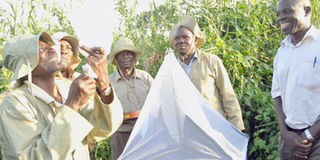Prime
Pastoralists in fear as tsetse fly infection spreads to Buvuma

Mr Fredrick Luyimbazi (R), an assistant commissioner in the Ministry of Agriculture, with other entomologists trap tsetse flies in Buvuma Island. Photo by Martin Ssebuyira
What you need to know:
Animals dying. Veterinary officers in the area say about 30 animals were killed by nagana last year alone.
Pastoralists and local authorities in Buvuma District have expressed worry over the increasing spread of trypanosomiasis (nagana) disease which has affected several animals and left others dead. The pastoralists say there are many tsetse flies on the island.
“Although tsetse flies have reduced because of the government interventions with the Creation of Sustainable Tsetse and Trypanosomiasis Free Areas (STATFA) project, Buvuma is still a heavily tsetse fly-infested area,” Mr John Kizito, a pastoralist at the island, said.
He said they normally buy chemicals to treat their animals but the dosage is too expensive since a litre goes for Shs80,000, which has made many farmers forego animal rearing.
Dr Richard Semirembe, the acting district veterinary officer, said about 30 animals were killed by the deadly disease last year.
“We get drugs from Kampala to assist farmers but it’s hard to cross from one island to another to assist farmers with infected animals,” he said.
Dr Semirembe wants government to give them more tsetse fly traps to reduce the flies in the area.
Mr Adrian Ddungu Wasswa, the district chairman, said other than tsetse flies affecting animals, they also spread sleeping sickness to people, which has recently killed one person and left others critically ill.
He said the district has been badly hit by these vectors in Busamuzi, Nairambi, Bweema, Bugaya and Luweero sub-counties.
“We have less staff to deploy tsetse traps around all the 56 sub-islands in Buvuma,” Mr Ddungu said.
He said government had given them some traps, boat engines and bicycles through the STATFA project but the problem is still persisting.
Mr Fredrick Luyimbazi, the assistant commissioner of entomology in the Ministry of Agriculture and also coordinator of the STATFA project, said Buvuma is one of the most tsetse fly-infested areas in the country with about 500 tsetse flies in a trap per day.
“This place is too big and having traps around the place could take ages yet there is need for aerial spraying to eliminate the problem,” he said, adding that the chemical is biodegradable and aerial spraying has registered success in Namibia, Angola and Okavango delta in Botswana.
He says since 160,000sq km of the land in the country is tsetse fly-infested, it puts 70 per cent of the national herd at risk of contracting nagana.



